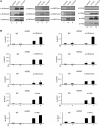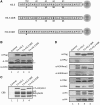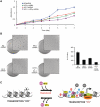Histone variant H3.3 stimulates HSP70 transcription through cooperation with HP1γ
- PMID: 21742762
- PMCID: PMC3201866
- DOI: 10.1093/nar/gkr529
Histone variant H3.3 stimulates HSP70 transcription through cooperation with HP1γ
Abstract
Histone variant H3.3 and heterochromatin protein 1γ (HP1γ) are two functional components of chromatin with role in gene transcription. However, the regulations of their dynamics during transcriptional activation and the molecular mechanisms underlying their actions remain poorly understood. Here, we provide evidence that heat shock-induced transcription of the human HSP70 gene is regulated via the coordinated and interdependent action of H3.3 and HP1γ. H3.3 and HP1γ are rapidly co-enriched at the human HSP70 promoters upon heat shock in a manner that closely parallels the initiation of transcription. Knockdown of H3.3 prevents the stable recruitment of HP1γ, inhibits active histone modifications, and attenuates HSP70 promoter activity. Likewise, knockdown of HP1γ leads to the decreased levels of H3.3 in the promoter regions and the repression of HSP70 genes. HP1γ selectively recognizes particular modification states of H3.3 in the nucleosome for its action. Moreover, HP1γ is overexpressed in three representative cancer cell lines, and its knockdown leads to reduction in HSP70 gene transcription and inhibition of cancer cell proliferation. We conclude that the physical and functional interactions between H3.3 and HP1γ make a unique contribution to acute HSP70 transcription and cancer development related to the misregulation of this transcription event.
Figures







Similar articles
-
Histone H3 lysine 4 trimethylation regulates cotranscriptional H2A variant exchange by Tip60 complexes to maximize gene expression.Proc Natl Acad Sci U S A. 2014 Apr 1;111(13):4850-5. doi: 10.1073/pnas.1320337111. Epub 2014 Mar 17. Proc Natl Acad Sci U S A. 2014. PMID: 24639513 Free PMC article.
-
Suppression and recovery of BRCA1-mediated transcription by HP1γ via modulation of promoter occupancy.Nucleic Acids Res. 2012 Dec;40(22):11321-38. doi: 10.1093/nar/gks947. Epub 2012 Oct 15. Nucleic Acids Res. 2012. PMID: 23074186 Free PMC article.
-
Nucleosome compaction facilitates HP1γ binding to methylated H3K9.Nucleic Acids Res. 2015 Dec 2;43(21):10200-12. doi: 10.1093/nar/gkv841. Epub 2015 Aug 28. Nucleic Acids Res. 2015. PMID: 26319017 Free PMC article.
-
Histone H3 lysine 9 methylation and HP1gamma are associated with transcription elongation through mammalian chromatin.Mol Cell. 2005 Aug 5;19(3):381-91. doi: 10.1016/j.molcel.2005.06.011. Mol Cell. 2005. PMID: 16061184
-
Transcriptional activation triggers deposition and removal of the histone variant H3.3.Genes Dev. 2005 Apr 1;19(7):804-14. doi: 10.1101/gad.1259805. Epub 2005 Mar 17. Genes Dev. 2005. PMID: 15774717 Free PMC article.
Cited by
-
Differential Expression of Histone H3.3 Genes and Their Role in Modulating Temperature Stress Response in Caenorhabditis elegans.Genetics. 2018 Jun;209(2):551-565. doi: 10.1534/genetics.118.300909. Epub 2018 Apr 10. Genetics. 2018. PMID: 29636369 Free PMC article.
-
Structural basis of the chromodomain of Cbx3 bound to methylated peptides from histone h1 and G9a.PLoS One. 2012;7(4):e35376. doi: 10.1371/journal.pone.0035376. Epub 2012 Apr 13. PLoS One. 2012. PMID: 22514736 Free PMC article.
-
HIRA directly targets the enhancers of selected cardiac transcription factors during in vitro differentiation of mouse embryonic stem cells.Mol Biol Rep. 2018 Oct;45(5):1001-1011. doi: 10.1007/s11033-018-4247-z. Epub 2018 Jul 20. Mol Biol Rep. 2018. PMID: 30030774 Free PMC article.
-
Loss of Nexmif results in the expression of phenotypic variability and loss of genomic integrity.Sci Rep. 2022 Aug 15;12(1):13815. doi: 10.1038/s41598-022-17845-1. Sci Rep. 2022. PMID: 35970867 Free PMC article.
-
Histone H3.3 chaperone HIRA renders stress-responsive genes poised for prospective lethal stresses in acquired tolerance.Genes Cells. 2024 Sep;29(9):722-734. doi: 10.1111/gtc.13140. Epub 2024 Jul 8. Genes Cells. 2024. PMID: 38977420 Free PMC article.
References
-
- Kouzarides T. Chromatin modifications and their function. Cell. 2007;128:693–705. - PubMed
-
- Henikoff S. Nucleosome destabilization in the epigenetic regulation of gene expression. Nat. Rev. Genet. 2008;9:15–26. - PubMed
-
- Albig W, Bramlage B, Gruber K, Klobeck HG, Kunz J, Doenecke D. The human replacement histone H3.3B gene (H3F3B) Genomics. 1995;30:264–272. - PubMed
-
- Tagami H, Ray-Gallet D, Almouzni G, Nakatani Y. Histone H3.1 and H3.3 complexes mediate nucleosome assembly pathways dependent or independent of DNA synthesis. Cell. 2004;116:51–61. - PubMed
Publication types
MeSH terms
Substances
Grants and funding
LinkOut - more resources
Full Text Sources
Molecular Biology Databases

